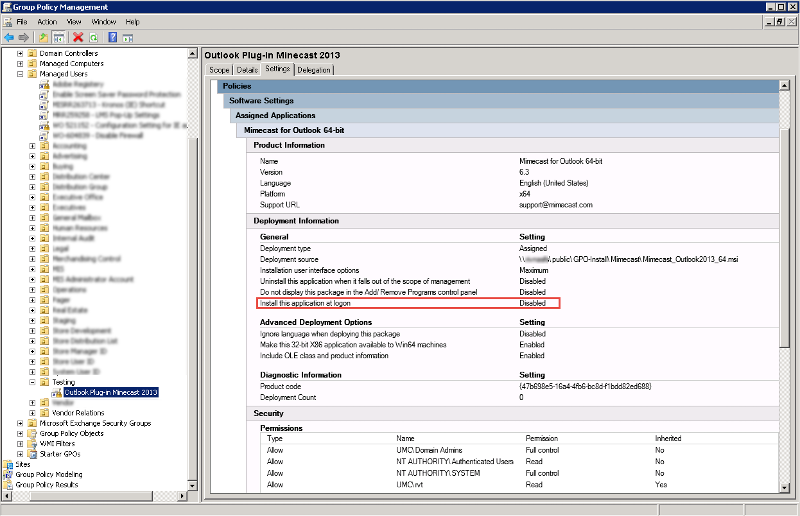

- #DEPLOY NON MSI SOFTWARE WITH GPO PDF#
- #DEPLOY NON MSI SOFTWARE WITH GPO INSTALL#
- #DEPLOY NON MSI SOFTWARE WITH GPO UPDATE#
- #DEPLOY NON MSI SOFTWARE WITH GPO UPGRADE#
- #DEPLOY NON MSI SOFTWARE WITH GPO WINDOWS#
RebootYesNo (default=Yes) – reboot after the installation INSTALLLOCATION - specify installation directory The list is not complete, here are some examples:ĪLLUSERS (default=1) - perform a per-user installation or per-machine installation depending on the access privileges of the userĬREATEDESKTOPLINK (default=1) - create desktop shortcut icon ( bugged in 4.1.0+, solved in tdf#65102 for 4.1.4 and 4.2.0)
#DEPLOY NON MSI SOFTWARE WITH GPO UPDATE#
We can completely remove the online update feature, taking it a step further than the ISCHECKFORPRODUCTUPDATES property:ĭuring installation you can set these properties.
#DEPLOY NON MSI SOFTWARE WITH GPO UPGRADE#
In an enterprise environment it is pointless as staff would normally not be able to upgrade their software. The online update feature is just a check to see if a more recent version is available, with a pop up a message to let the user know when there is. REMOVE=gm_o_Xsltfiltersamples,gm_o_jf_Palm,gm_o_jf_Pocketp REMOVE=gm_o_Extensions_PRESENTER_SCREEN,gm_o_Extensions_REPORTDESIGN Similarly, we can remove predefined extensions or components like this: REMOVE=gm_r_ex_Dictionary_Af,gm_r_ex_Dictionary_An Dictionaries are also installed as predefined extensions but in the installer process these are categorized as Dictionaries, so you need to add an extra part to the REMOVE like this: If you use ADDLOCAL=ALL all the dictionaries will be installed, select the ones you want to remove by their language codes, see below for examples of these codes. REMOVE=, Everything you want to remove must be specified in one string using comma as separator and no spaces.
#DEPLOY NON MSI SOFTWARE WITH GPO INSTALL#
If you want to manipulate the installed components with parameters you must first either identify every single component you want to install or (better) install everything with the parameter ADDLOCAL=ALL and then define everything you don't want with REMOVE.
#DEPLOY NON MSI SOFTWARE WITH GPO PDF#
First save it locally, then open the PDF from within LibreOffice and edit it as you would a normal document.įile:Office Suite And Editable Document Format Upgrade Options.pdf Silent and Unattended Installationsįeature and Property parameters can be used as command line options.ĪDDLOCAL=ALL, The installed features are core components and they pretty much correspond with the page in the dialog that is only available if you select Custom installation from the GUI.

It is for upgrading to LibreOffice from Microsoft Office 2003 you could easily adapt it for a proposal to upgrade from another office suite such as Microsoft Office 2007 or 2010. Here is a well-written and compelling business case proposal that works.

Also see the TDF migration protocol Business case proposal for upgrading to LibreOffice iIt can be configured as the default for OpenDocument files, and other file type defaults can be left as they are until you commence your migration.Ī deployment and migration white paper is available to help with a migration. This could involve running an installation of LibreOffice alongside an existing office suite. Testing Plan, Deployment and Migration Planīefore a migration you need a testing plan. WPKG is an automated software deployment, upgrade and removal program for Windows.For hundreds of computers get a knowledge of editing MSIs, perhaps using an MSI editor such as ORCA.Dozens, or hundreds of computers, use Group Policy computer startup scripts.A few dozen computers, simply run a batch file based on the examples given below at each computer.For a handful of computers, perhaps up to a dozen, it is probably quickest to just use the GUI at each computer.There are many ways to install LibreOffice, and some are as follows: Whereas LibreOffice 3.4 and below were seperate files, an EXE file which contained NSIS pre-installer + a setup.exe loader + an MSI file + a separate CAB file + many language transforms + VC redistributable files. LibreOffice 3.5 and above is an MSI file with everything embedded, containing language transforms as substorages, VC redistributables as merge modules and a CAB file is embedded too. will not be uninstalled, but you do need to remove the OpenOffice Quickstart if LibreOffice is to be your primary office suite. Versions lower than 3.4.5 should be uninstalled prior to installation. You do not need to uninstall an earlier version of LibreOffice if it is version 3.4.5 or higher preferences are preserved and the old installation will be overwritten. a 64-bit version for 64-bit Windows, starting with LibreOffice 5.0.
#DEPLOY NON MSI SOFTWARE WITH GPO WINDOWS#


 0 kommentar(er)
0 kommentar(er)
